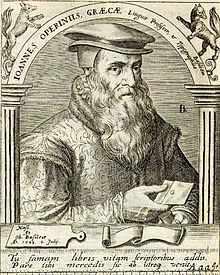Oporinus
| Johannes Oporinus | |
|---|---|

Engraving by Theodor de Bry
|
|
| Born |
25 January 1507 Basel |
| Died | 6 July 1568 (aged 61) Basel |
| Residence | Basel |
| Nationality | Swiss |
| Known for | Publication of Vesalius; first printed Koran amanuensis of Paracelsus |
| Scientific career | |
| Fields |
printing, medicine, classical philology |
| Institutions | University of Basel |
Johannes Oporinus (original German name: Johannes Herbster or Herbst) (25 January 1507 – 6 July 1568) was a humanist printer in Basel, the son of the painter Hans Herbst.
Johannes Oporinus was born in Basel the son of the painter Hans Herbst. He completed his academic training in Strasbourg and Basel. After working as a teacher in the Cistercian convent of St. Urban, he returned to Basel, where he worked as a proofer in the shop of Johann Froben, the most important Basel printer of the early 16th Century. In addition, he taught at the Basel Latin school from 1526. After 1537 Oporinus taught Greek at the University of Basel. In 1542 he resigned his academic post to devote himself full-time to his printing workshop. In addition, he completed a medical studies and was temporarily famulus to the iconoclastic physician Paracelsus.
The first edition of the Latin Koran in 1542/43 edited by Theodor Bibliander (the first printed Koran worldwide) from a translation made by Robert of Ketton in Spain between 1142 and 1143 by command of Peter the Venerable caused Oporinus serious difficulties. The Basel city council wanted to prevent the publication but yielded due to the intervention of Martin Luther and Philip Melanchthon. In October 1546 a book on the assassination of the Spanish Protestant Juan Díaz entitled Historia vera de morti sancti viri Ioannis Diazii Hispanics [...] by Claudium Senarclaeum was published by his workshop, which is attributed to Francisco de Enzinas. Oporinus later printed the works on church history by Matthias Flacius Illyricus (Catalogus testium veritatis1556 and 1562) and began the publication of the Magdeburg Centuries (1559–1574) of which only the ages 1–13 were completed.
...
Wikipedia
